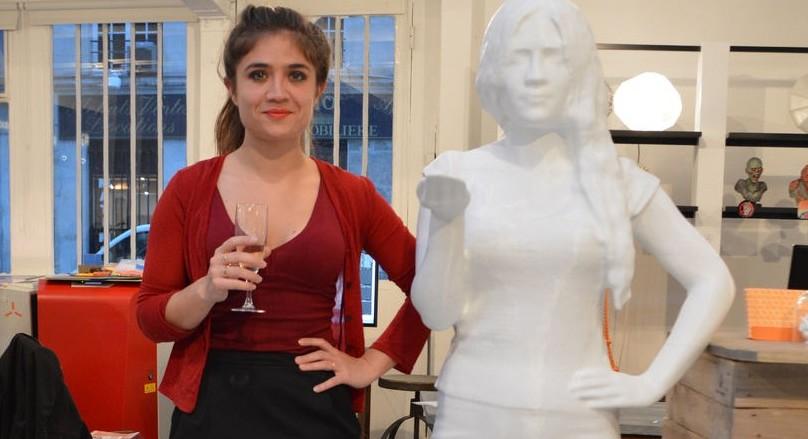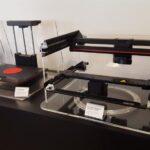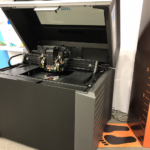

When French 3D design company Le FabShop set up its booth near the Shapify space at the Autodesk Pop-Up Gallery in Paris last October, one young designer with Le FabShop, Samuel N. Bernier, could not resist collaborating with the neighbors. Le FabShop is a major distributor of Makerbot 3D printers and scanners in France, organizes Maker Faires, and provides retailers such as the upscale gift shop at the Versailles Palace with high-quality 3D printed objects such as architectural models. Shapify, a branch of Artec, the 3D scanner manufacturer, has begun setting up 3D scanning photo booths in Europe, the UK, and the US. The booths allow users to create full-body 3D scans and then 3D prints of the scan subjects. In short, they are 3D photo booths.
Enter Le FabShop’s young maker, who saw an opportunity to combine the resources of Le FabShop and Shapify to pay homage to his unnamed fiancée. While he wanted to use the 3D photo booth to create a model, which he could print in his company’s booth using a MakerBot printer, he confessed, “I already had about a dozen miniatures of myself.” He decided instead to create a life-size, 3D printed model of the young woman to whom he had recently proposed marriage — a romantic gesture, if not a bit “creepy” (his words), particularly as the finished model is a ghostly, uniform white.
Thankfully, he not only decided to create the life-sized fiancée, he also shared his design and process with us all. If you’re so inclined, you can follow Bernier’s steps to set your own love on a (literal) pedestal by 3D printing the love of your life — it’s all on Instructables.
In the course of creating the 3D full-body scan in the Shapify photo booth, the designer had some helpful advice to offer for future photo booth users:
1. Do not wear black as it absorbs light and creates difficult-to-discern geometries.
2. Do not wear reflective fabrics as they reflect the light and are not scannable. [Note that this also goes for shiny objects like engagement rings! Maybe paint one on at the end instead of trying to scan a real diamond.] 3. Transparent objects like glasses will not scan well. You may as well remove your glasses and add them to the 3D model afterwards, using a program like Meshmixer.
4. Hold still! Obviously, any movement distorts the final scan.
5. Decide whether your final print is going to be multi-colored or monochromatic. If the former, be colorful as this designer observes that “multi-color patterns work so much better.”
6. Depart from the ordinary: try a less conventional pose.
Once Bernier had accomplished the 3D scan of his fiancée, he used a 3D modeling program to refine the image. He suggests using Netfabb or Meshmixer (the former can be purchased and the latter can be downloaded free of charge). As the goal was to print a life-size model, the 3D designer used the cutting tool in the modeling program to slice the object into segments to be printed separately. The segments were sized according to the capacity of the 3D printer; that is, they were as large as the printer could accommodate.

The completed statue, printed in parts, weighed about 20 pounds and took approximately 500 hours to print, so there’s a substantial time materials commitment involved in creating life-size objects. As the finished statue is for display only and does not need to be particularly durable, it makes sense to limit the infill — they used 2 and 3% infill.
Once the printing was accomplished, the Le FabShop team assembled the separate segments of the figure… granted, they hit some snags in the process (quickly learning, after a few broken pieces that needed to be reprinted, not to use double-stick tape), but ultimately used strong silicone glue and mounted the statue of Bernier’s fiancée on a wooden stand. This adds to the time commitment, as the glue takes around 12 hours to cure completely, but Bernier assures that using the right material “is worth the wait.”
It is a somewhat eerie — and amusing — tribute to the young maker’s future wife and might only have been surpassed in peculiarity by a 3D model of him on bended knee proposing to her.
Would you want to immortalize — or be immortalized by — your love? Is a life-sized, exact replica “creepy, but cool,” as Bernier suggested? Let us know what you think! Check out the 3D Printed Fiancée forum thread at 3DPB.com.
If you're looking to get architectural 3D animation in the USA, our service provides an exceptional way to bring your architectural concepts to life through dynamic, immersive visuals. Through our platform, you can easily request high-quality 3D animations that showcase your designs in motion, offering a detailed view of your project from multiple angles and perspectives. Whether it's for a real estate development, a commercial building, or an urban planning project, our expert team ensures that every detail is captured in a visually compelling animation.
Through our website, you can seamlessly get architectural 3D animation tailored to your project’s specific needs. With our help, you can offer potential clients or investors an engaging experience that goes beyond static images. By integrating CGI animations with real-world settings, lighting, and textures, our team creates a lifelike experience that allows your audience to interact with your project as though it were already built. This service is perfect for presenting complex designs in a clear, visually attractive way that stands out in the competitive architectural market.




